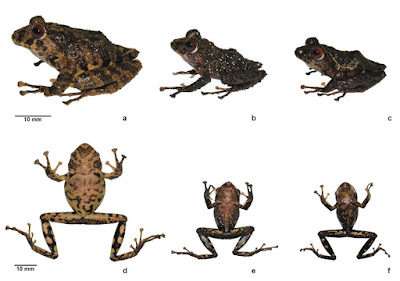 |
| Pristimantis ledzeppelin Brito-Zapata & Reyes-Puig, 2021 |
ABSTRACT
We describe a new species of Pristimantis from the Comunidad Río Blanco, Cordillera del Cóndor, Ecuador. Pristimantis ledzeppelin sp. nov. is characterized by a snout–vent length of 23.9–24.6 mm in adult males (n = 2) and 36.1 mm in one adult female and is compared morphologically with Pristimantis muscosus and other similar species of Pristimantis. The new species is characterized by having skin on dorsum and flanks finely tuberculate to tuberculate, a distinctive scapular fold, skin on venter coarsely areolate; snout rounded with a small rostral papilla; discs on the digits truncate, three times the width of the digits; groin and hidden surfaces of thighs yellowish-cream with distinctive brownish-black marks and/or orange irregular blotches; and coppery red iris.
KEYWORDS: Montane forest, Pristimantis ledzeppelin sp. nov., Comunidad Río Blanco, Terrarana
Pristimantis ledzeppelin sp. nov.
Proposed standard English name. Led Zeppelin’s Rain Frog
Proposed standard Spanish name. Cutín de Led Zeppelin
Diagnosis: A new species of Pristimantis having the following combination of characters: (1) skin on dorsum and flanks finely tuberculate to tuberculate, with “W” shaped scapular fold (reduced by preservation effects); dorsolateral folds absent; skin on venter coarsely areolate; discoidal fold present; (2) tympanic membrane and tympanic annulus present, round, equivalent to 31.4% of ED; supratympanic fold present, extending from the eye insertion towards the posterior edge of the tympanum, covering 1/8 of the tympanum; with several conical to subconical postrictal tubercles, prominent; (3) snout rounded with a small rostral papilla in dorsal view, moderate in length and rounded in lateral view (Figure 1); a row of subconical tubercles on the lower jaw; (4) upper eyelid with one evident subconical tubercle on the center of eyelid, surrounded by several lower subconical tubercles (less evident in preserved specimens) (Figure 1); EW 89% of IOD; cranial crests absent; (5) dentigerous processes of vomers, prominent, triangular in outline, with three to four teeth, moderately separated, posteromedial to choanae; (6) vocal slits absent, nuptial pads present; (7) Finger I shorter that Finger II, discs of digits broadly expanded, truncate; three times the width of the digits on Fingers II to IV; (8) fingers with narrow lateral fringes; (9) ulnar tubercles present, subconical; (10) heel bearing one conical tubercle surrounded by two to five subconical low tubercles (less evident in preserved specimens), outer edge of tarsus bearing 4–6 subconical tubercles, inner tarsal fold absent; (11) inner metatarsal tubercle oval, 6X times the outer metatarsal tubercle that is subconical; supernumerary plantar tubercles present, evident, distributed throughout the plantar surface (Figure 3); (12) toes with narrow lateral fringes, discs slightly less wide than those of fingers, discs of digits broadly expanded, truncate; three times the width of the digits on toes II to V, webbing basal; Toe V longer that Toe III, disc on Toe V reaches and exceeds the distal subarticular tubercle on Toe IV; (13) in life, dorsum from background beige with irregular transversal dark brown marks to greenish-brown with scattered cream dots; groin and hidden surfaces of thighs yellowish-cream with distinctive brownish-black marks (more widespread in males) and/or orange irregular blotches; venter yellowish-cream to light brown with coppery tones and marbling with dark brown; ventral surfaces of the calf brownish-black enclosing yellowish-cream to yellowish-orange blotches. Coppery-red iris with thin brown reticulations; (14) SVL in two adult males 24.3 ± 0.3 (23.9–24.6 mm); in one adult female 36.1 mm.
Etymology: The name honours Led Zeppelin and their extraordinary music. Led Zeppelin was a British rock band formed in London in 1968, one of the most influential bands throughout the 1970s, and progenitors of both hard rock and heavy metal.
David Brito-Zapata and Carolina Reyes-Puig. 2021. A New Species of Terrestrial-breeding Frog Pristimantis (Anura: Strabomantidae) from the Cordillera del Cóndor, Zamora Chinchipe, Ecuador. Neotropical Biodiversity. 7(1); 213-222. DOI: 10.1080/23766808.2021.1940048
Resumen: Describimos una nueva especie de Pristimantis de la Comunidad de Río Blanco, Cordillera del Cóndor, Ecuador. Pristimantis lezeppelin sp. nov. es caracterizada por una longitud rostro-cloacal de 23.9–24.6 mm en machos adultos (n = 2), 36.1 mm en una hembra adulta, y es comparada morfológica con Pristimantis muscosus y con otras especies similares de Pristimantis. La especie nueva se caracteriza por tener la piel del dorso y flancos finamente tuberculada a tuberculada, un pliegue escapular distintivo, piel en el vientre fuertemente aerolada; hocico redondeado con una pequeña papila rostral; discos de los dígitos truncados, tres veces el ancho de los dígitos; ingles y superficies ocultas de los muslos crema amarillentas con marcas distintivas café-negruzcas o negras con manchas irregulares crema amarillentas y naranja; e iris rojo-cobrizo.
Palabras clave: Bosque montano, Pristimantis ledzeppelin sp. nov., comunidad Río Blanco, Terrarana

